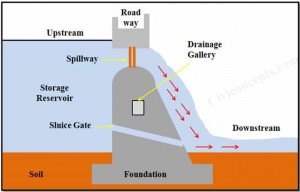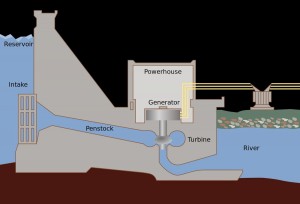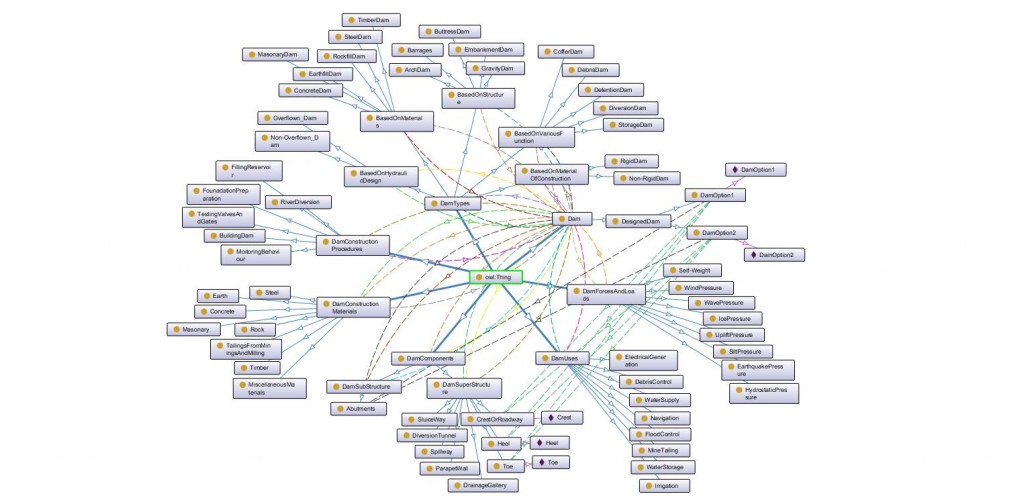Introduction
Figure 1: Overview of a Dam
A dam is a water-retaining structure built over a stream, river, or estuary. Dams are constructed to supply water for human use, irrigation of desert and semiarid terrain, and industrial processes. They’re used to enhance the amount of water available for hydroelectric power generation, to lessen the peak discharge of floodwater caused by large storms or high snowfall, or to increase the depth of water in a river to improve navigation and make it easier for barges and ships to travel. Multipurpose dams are a common name for these types of water-control structures. Spillways, movable gates, and valves that control the release of surplus water downstream from the dam are examples of auxiliary works that can assist a dam function correctly. There are a number of causes of failure of a Dam. One of the major failures is the Overturning of the Dam toe. Other failures are sliding causing shear failure, compression, and tension.
The dam is definitely a complex product to understand its working. There are several kinds of dams based on different functions. Through Ontological Modelling, we get a classification and explanation of entities. And through Parametric Modelling, we can get the model of the structure. Both of these ways help customers and the stakeholders to get a clear-cut idea of the project to be taken forward.
Figure 2: Schematics of a Dam
Design Goals (Scope)
The engineering design challenges of the dam include Stress and stability analysis of dam foundations under external loads, earthquake behaviour of dam–foundation–reservoir systems, mechanical properties of mass concrete for dams, high-velocity flow and energy dissipation for high dams, and technical problems of hydropower plants and underground structures. The ultimate aim to take the dam as a system was to dismantle all classifications, faliure posibbilities and to give a clear idea of the working of the system. Through Ontological Modelling and Parametric Modelling we were able to achieve the objective to be met.
Ontology Model
All of these parameters and design configurations, in addition to the most essential aspects of the product, are well captured in the ontology model.
Figure 5: Ontology Model for Dam
PURPOSE: The purpose of this ontology is to showcase the conceptual design of dam construction.
SCOPE: This ontological model consists of all the details regarding the construction of a dam. It provides information on the components of the dam & its application, types of the dam, materials used for the construction of the dam, forces acting on it along the design of an arch dam.
INTENDED USERS: The intended Users are the Designers, Engineers, and stakeholders who are involved in the designing process and construction of a Dam.
INTENDED USE: This ontology can be used to gain an idea about the basic design parameters to be considered for the construction of a Dam. Since ontology about dams is a very vast subject to be studied to acquire knowledge, this ontology can be further integrated. There are enormous types of parameters affecting a dam, whereas in this ontology we have considered the primary stages to get an idea about it.
Parametric Model
As per the design parameters, 6 parameters have been considered to design the structure of the dam.
- Height of the Dam
- Dam Radius
- Toe Width
- Heel Width
- Crest Width
- Dam Opening Angle
- Spillway Length
- Spillway Width
Each of the parameters and given values are according to the dam to be modelled.
The modelling of the dam is done in four parts: Design of the main axis, Design of Dam Structure, Application of Spillway plane and Design of Spillway Structure.
Establishing High-Performance Criteria is one of the important things to be considered. In the case of the dam, one of the major reasons for the failure of the dam is overtopping, as well as structural instability due to uplift pressure. I have considered the same, as both of the high-performance criteria are affected by several design parameters.
References
https://www.earthreminder.com/different-types-of-dams-and-components/
WILDI, Walter. Environmental hazards of dams and reservoirs. In: NEAR curriculum in Natural Environmental Science. Genève : Section des sciences de la Terre et de
l’environnement, 2010. (Terre & Environnement; 88) https://archiveouverte.unige.ch/unige:90831
Ontology Development101: by Natalya F. Noy and Deborah L. McGuinness
Environmental Effects of Dams and Impoundments: R. M. Baxter. Annual Review of Ecology and Systematics 1977 8:1, 255-283


